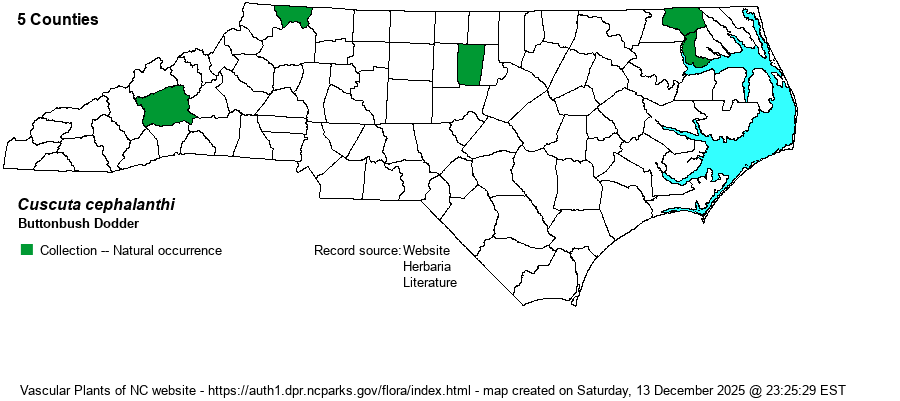| Author | Engelmann | |
| Distribution | Collections known from just five counties -- two from the Mountains, one from the Piedmont, and two from the northern Coastal Plain. This wide scatter of records possibly indicates botanical apathy in collecting members of the genus.
This is a widespread but seemingly scarce species, ranging from southern Canada to GA, TX, and CA -- with many states lacking or having very few collections. | |
| Abundance | Seemingly very rare to rare across the state; as with all Cuscuta species, it is probably grossly under-collected, but it seems to be legitimately scarce, at least relative to most other dodder species. Details of abundance/rarity in the provinces is not clear at the present time, but in VA most records are from the eastern Coastal Plain. This is a Significantly Rare species. The website editors suggest a State Rank of S1?, instead of the NCNHP's S1, for two reasons -- the known records occur across the state, and it is presumably under-collected. | |
| Habitat | This dodder grows on woody hosts, such as Buttonbush (Cepalanthus occidentalis). In VA, the habitats are "Tidal swamps, alluvial swamps, wet clearings" (Digital Atlas of the Virginia Flora website); thus, it should occur mostly in wetland habitats in NC as well. | |
| Phenology | Flowers in August and September, and fruits shortly after flowering. | |
| Identification | See Taxonomic Comments. The description as taken from Gleason (1952): "Flowers mostly 4-merous, about 3 mm. long, sessile or short-petioled in loose clusters. Calyx shorter than the corolla-tube, its lobes obtuse. Corolla-lobes ovate, obtuse, erect to spreading, about half as long as the tube." | |
| Taxonomic Comments | Most references have or had the scientific epithet as cephalanthii, but the single "i" at the end seems to be correct, according to Weakley (2018).
The species of Cuscuta all share a few similar features, and they are difficult to separate except by mostly small characters, best seen with a hand lens or microscope. Each is a parasitic vine, lacking roots or true leaves, and nearly all are orange or yellow in color, twining up its host plant with the use of tiny aerial "roots". The small white flowers are in clusters along the stem. These plants should be quite familiar as a group, often presenting a tangled mass of orange vines growing over other plants. See Weakley (2018) or other references for keys to assist in identification. | |
| Other Common Name(s) | None | |
| State Rank | S1 [S1?] | |
| Global Rank | G5 | |
| State Status | SR-T | |
| US Status | | |
| USACE-agcp | | |
| USACE-emp | | |

